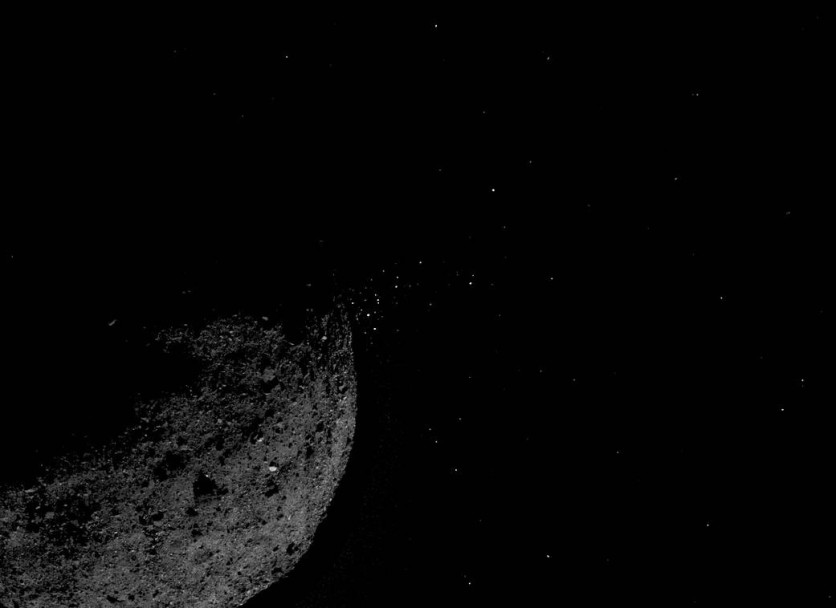NASA has released images taken by navigation camera's (NavCam 2) field of view on October 20 when OSIRIS-Rex touched and took samples from the surface of asteroid Bennu, as reported by SciTech Daily.
During NASA's sample collection event of the OSIRIS-REx mission, the spacecraft was brought from site Nightingale. The sampling arm's shadow is seen in the lower part of the video as the spacecraft came to the site, Nightingale.

Then, the sampling head impacts the site Nightingale and fires a nitrogen gas bottle to activate a substantial amount of materials. NavCam 2 captured these images while the team on Earth got confirmation of the successful Bennu touchdown at 6:08 pm EDT.
After a brief six seconds, the sampling head touched the asteroid's surface before the spacecraft did a back-away burn while the shadow of the sampling arm is again visible alongside the unsettled materials on the asteroid's surface.
NASA shared the footage on Twitter
NASA's OSIRIS-Rex account shared on Twitter a clip of the Bennu touch-and-go mission since "the sample is sealed up in the Sample Return Capsule." "This is the view from one of my navigation cameras... pretty intense, huh? #ToBennuAndBack," the tweet said.
Now that the sample is sealed up in the Sample Return Capsule, I can finally share this video from TAG! This is the view from one of my navigation cameras… pretty intense, huh? #ToBennuAndBack More details: https://t.co/JUSk8YDaow pic.twitter.com/TqPUm9YBvU — NASA's OSIRIS-REx (@OSIRISREx) October 30, 2020
Well, the footage excited science buffs, and one even inquired when the spacecraft would return. Richard Butler said: "I love this, and to be honest, I think how it corrects its landing trajectory is so cool. That was all done by itself? SO COOL. When does it begin its return and will we have more video?"
Other Twitter users were curious about the color of the samples since the video appeared in black and white cameras. "would it actually be brown though? I kinda assumed that it was just grey but I do know NASA have used black and white cameras before I think," blizz tweeted.
would it actually be brown though? I kinda assumed that it was just grey but I do know NASA have used black and white cameras before I think — blizz (@fairyflosslord7) October 30, 2020
"They do often use b&w photos for sharper detail, but in this case I'm pretty sure Bennu is indeed dark grey and this colorization is wrong," another user said adding the OSIRIS-REx has at least one colored camera as shown in color pictures of the Earth during the C-type asteroid's flyby.
They do often use b&w photos for sharper detail, but in this case I'm pretty sure Bennu is indeed dark grey and this colorization is wrong. OSIRIS-REx DOES have at least 1 color camera (there are color pictures of Earth from a flyby) and Bennu is a C-type asteroid anyway — what (@VulpesAntares) October 31, 2020
NavCam 2, a black-and-white camera, is one of OSIRIS-REx's three cameras for its Touch-and-Go Camera System (TAGCAMS). TAGCAMS was built by Malin Space Science Systems and operated by Lockheed Martin Space. It is included in the spacecraft's navigation, control, and guidance system.
Related article : NASA's OSIRIS-REx Locked-and-Loaded with Asteroid Bennu's Sample; Now En-Route Back to Planet!
The Bennu TAG images
The footage was captured within a three-hour period, which began approximately one hour after the spacecraft performed the orbit departure maneuver. The spacecraft rotates in the middle of the video, so the NavCam 2 looked away from the asteroid, then it did a final slew and pointed the camera as well as the sampling arm again toward Bennu's surface. The clip ended a couple of minutes after a back-away burn.

The video was created using 189 images taken by the NavCam 2 for the spacecraft's navigation system, Natural Feature Tracking (NFT), which let the OSIRIS-Rex navigate autonomously to Bennu's surface using the built-in imagery catalog and comparing them with actual images. The NavCam 2 took pictures of Bennu's surface during the sampling event, so the NFT could update the spacecraft's position as it descended towards the target touchdown area.

With the recent images, scientists are currently investigating what triggered the extremely dark areas seen in the middle and upper sections of the images. While they suspect, the shadow on the upper area may be due to the sampling arm or the shadow cast by surface materials. For the middle part, they could be a depression caused by a spacecraft thruster or the lofted material.
This is owned by Tech Times
Written by CJ Robles
ⓒ 2025 TECHTIMES.com All rights reserved. Do not reproduce without permission.




